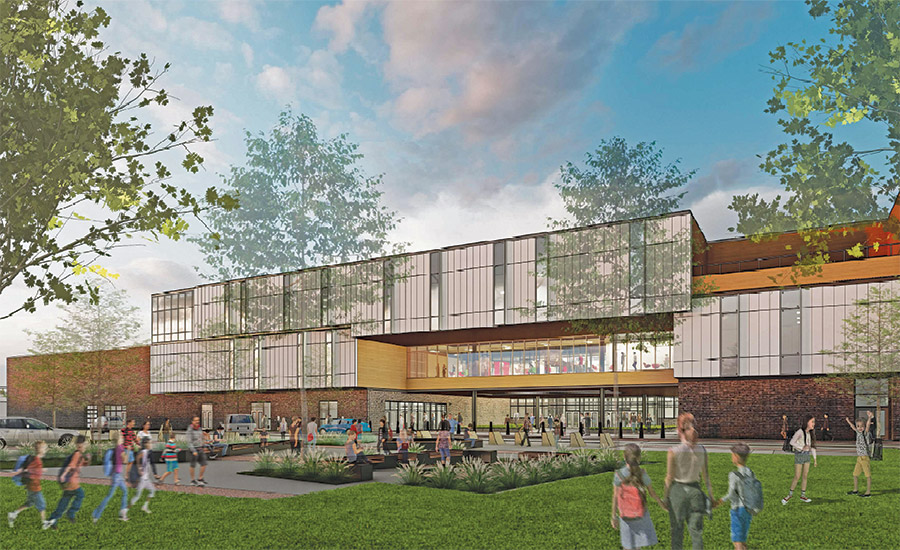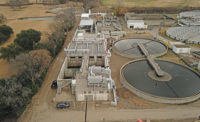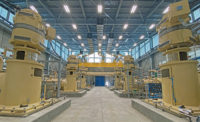Richardson ISD’s Lake Highlands Junior High opened its doors in the fall of 1960, housing both the junior and senior high schools until 1965, when it began serving 7th-, 8th- and 9th-grade students for more than 30 years before becoming the Lake Highlands Freshmen Center in 1999.
The school will soon begin a new chapter as general contractor Cadence McShane Construction and architect Perkins+Will celebrated groundbreaking on the new Lake Highlands Middle School on Sept. 7. This transition to the middle school model will result in the first-ever 6th-through-8th-grade campus in Richardson ISD.
The new school will feature a 231,000-sq-ft, three-story building. Perkins+Will and Cadence McShane worked together through the design phase to maximize site amenities. Improvements will include approximately 200 parking spaces, additional storage and landscaped outdoor areas. In tornado-prone North Texas, the gyms also will act as storm shelters made from insulated concrete forms, steel framing and concrete roof decking. The campus is expected to accommodate 1,500 students. Completion is scheduled for fall 2024.
Renewable Energy Coming to University of Arkansas Campus
Over the next 25 years, the University of Arkansas is expected to save millions of dollars in electricity costs and cut greenhouse gas emissions by 8.8% due to a new solar services agreement signed by the UA System president, Donald Bobbit, on July 18.
The agreement, which is expected to save more than $200,000 in its first year, will create sustainable energy from multiple solar panels at a new 25-acre facility located off campus.
After a competitive selection process, the university selected Entegrity Energy Partners of Little Rock to facilitate the project. Entegrity will provide all capital costs, design, permitting, installation, utility interconnection, operations and maintenance of the solar array and provide energy as a service to the UA campus.
The campus will purchase the energy output of the array at a specified rate over the 25-year contract term. The facility has a minimum guaranteed production of 8,688,880 kWh in the first year, which is approximately 6.3% of the electrical energy requirement of the campus.
CPRA Partners with Louisiana Community and Technical College System
The Louisiana Coastal Protection and Restoration Authority (CPRA) on Sept. 15 announced a partnership with the Louisiana Community and Technical College System (LCTCS) to develop training and certification programs around anticipated workforce needs to support construction of the Mid-Barataria Sediment Diversion, among other large-scale coastal infrastructure projects set for construction.
According to CPRA, the Mid-Barataria Sediment Diversion is projected to bring more than 12,000 direct and indirect jobs to southeastern Louisiana, largely concentrated in Plaquemines, St. Bernard, Jefferson and Orleans parishes. The project is intended to strategically reconnect the Mississippi River to the Barataria Basin, an area experiencing some of the highest rates of land loss in the world.
The project, planned for the west bank of the Mississippi River at river mile 61 in Plaquemines Parish, is set to receive a permitting decision from the U.S. Army Corps of Engineers by the end of 2022. Should CPRA receive a permit, construction activities could start in early 2023, according to the agency. Once complete, a man-made channel approximately two miles long will deliver sediment and nutrients from the river and deposit it in the basin to rebuild and sustain wetlands that provide critical storm surge protection to coastal communities. CPRA says the project is the first of its kind, representing billions in investment into coastal Louisiana, and has the capability to build more than 17,000 acres of land in the Barataria Basin.
Individuals skilled in carpentry, concrete finishing, heavy machinery and equipment operation, mill-wrighting, pile-driving, pipe laying and land surveying will be needed to support project construction. Job opportunities related to administration, accounting, project controls, engineering and general construction labor are also expected.
The project’s construction manager at-risk (CMAR) contractor is Archer Western-Alberici. CPRA and Archer Western-Alberici have committed to prioritizing the use local talent and working closely with LCTCS, which will administer the programming at the colleges most accessible to coastal Louisiana residents and workforce, ensuring that the specializations and skills needed for construction activities are appropriately integrated into the curriculum.
Updates on the project, including information on training programs through LCTCS, upcoming events, job fairs, public meetings and employment opportunities related to the Mid-Barataria Sediment Diversion will be available at midbasin.coastal.la.gov and lctcs.edu.
Bernhard Capital Launches AEC Platform
Bernhard Capital Partners Management LP announced Sept. 7 the launch of a dedicated AEC platform with an investment in Grace Hebert Curtis Architecture (GHC). GHC will continue to be led by CEO Jerry Hebert and its current management team, which will retain a significant stake in the business. Financial terms of the transaction were not disclosed.
Bernhard Capital plans to leverage its critical infrastructures services expertise with this platform to partner with businesses supporting the growing demand for modern, sustainable infrastructure.

On Aug. 16, MetroNational, E.E. Reed Construction and Kirksey Architecture celebrated the topping out of 9753 Katy Freeway. The project is a 187,400-sq-ft, nine-story core and shell office building that features a two-story lobby. The project is located in Houston’s bustling Memorial City area and is scheduled to be completed in April 2023.
Photo courtesy of E.E. Reed Construction
Waterloo Tower Completion
LV Collective, an Austin-based multifamily and student housing developer, announced Aug. 8 that it has delivered its latest project, Waterloo Tower, located at 2400 Seton, near the University of Texas at Austin. The 30-story multifamily, student-oriented building broke ground in 2020, near the start of the pandemic, and was delivered ahead of schedule.
Totaling 229,728 sq ft, the development has 241 units and 796 beds. The project reached 100% occupancy during the preleasing period and is now accommodating students for the fall 2022 semester.
The 300-ft-tall structure was made possible by the density bonus amendment made to the University Neighborhood Overlay in November 2019. With UNO, developers can build more units than allowed by a site’s base zoning if they agree to set aside a portion of units for income-restricted affordable housing as defined by the city’s SMART Housing programs. For Waterloo Tower, this meant allocating two floors, or 20% of the total units, to affordable housing. The calculations resulted in 10% of the units going to residents earning no more than 60% of Austin’s median-family income and the other 10% of the units for those earning no more than 50% of the MFI.
JE Dunn was general contractor and Boka Powell the architect. TBG Partners was landscape architect, DCI served as structural engineer and Quest Group was the civil engineer.





Post a comment to this article
Report Abusive Comment